Union Pacific Bundle
Who Really Calls the Shots at Union Pacific?
Ever wonder who truly steers the massive freight train that is Union Pacific (UP)? Understanding Union Pacific ownership is key to grasping its strategic moves and future prospects. As a critical player in North America's supply chain, UP's ownership structure directly impacts its operations and, consequently, the broader economy. This deep dive will uncover the forces shaping this railroad company.
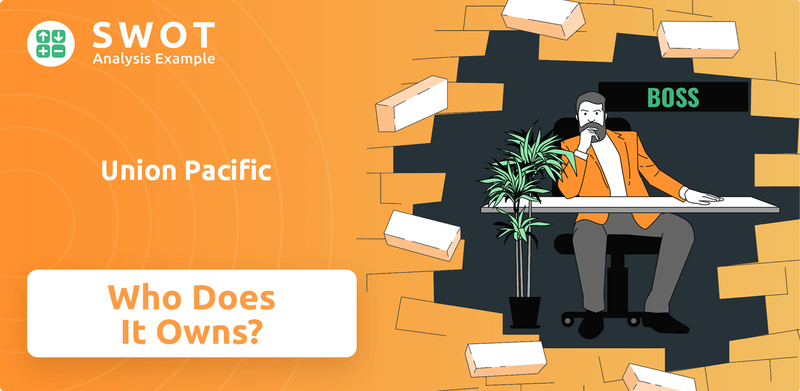
From its roots in the 19th century to its current status as a publicly traded entity, the evolution of Union Pacific ownership tells a compelling story. This analysis will explore the influence of major stockholders, the role of the board of directors, and recent trends impacting Union Pacific SWOT Analysis. We'll examine who owns the most shares of Union Pacific and how investors can navigate this landscape, considering factors like Union Pacific stock price and financial performance. This exploration is essential for anyone interested in understanding how to invest in Union Pacific and its future.
Who Founded Union Pacific?
The Union Pacific, a prominent railroad company, began its journey in 1862. Established as one of the two original companies tasked with constructing the first U.S. transcontinental railway, it was chartered under the Pacific Railway Act of 1862, signed by President Abraham Lincoln.
Early control of the UP underwent several transformations. Initially, the company was under the purview of the federal government. However, ownership and influence shifted over time, with key figures like Jay Gould playing a significant role in its development.
The evolution of UP’s ownership reflects its complex history, marked by financial challenges and strategic maneuvers. From its inception to its reorganization, the company's ownership structure has been a dynamic aspect of its operations.
Financier Jay Gould gained control of UP in the 1870s. He expanded the rail network significantly during his tenure.
In 1880, UP consolidated with the Kansas Pacific Railway and Denver Pacific Railway. Gould controlled all three entities under a new holding company, Union Pacific Railway.
The Union Pacific Railway faced bankruptcy in the Panic of 1893. This was due to factors including fraud and new competition, leading to government receivership.
A new UP Railroad Company emerged from receivership in 1898. E. H. Harriman took control after a bankruptcy plan sponsored by Kuhn, Loeb & Co.
E. H. Harriman's son, W. Averell Harriman, served as chairman of the board from 1932 to 1946. This marked a period of stability and growth for the company.
Early UP stockholders included a mix of investors who believed in the potential of the transcontinental railroad. These investors played a key role in the company's initial capitalization and expansion.
The ownership structure of UP has evolved significantly since its founding. The company's history is marked by periods of financial instability and strategic shifts in control. Understanding the historical context of UP's ownership provides insight into its present-day structure and operational strategies. As of the latest available data, UP is a publicly traded company, with major institutional investors holding significant shares. The current market capitalization of UP is approximately $140 billion as of early 2024, reflecting its position as a major player in the railroad industry. The company's stock symbol is UNP.
The evolution of UP’s ownership reflects its complex history, marked by financial challenges and strategic maneuvers.
- 1862: Founded under the Pacific Railway Act.
- 1870s: Jay Gould gains control.
- 1880: Consolidation under Union Pacific Railway.
- 1893: Bankruptcy and government receivership.
- 1898: Reorganization under E. H. Harriman.
- 1932-1946: W. Averell Harriman as chairman.
Union Pacific SWOT Analysis
- Complete SWOT Breakdown
- Fully Customizable
- Editable in Excel & Word
- Professional Formatting
- Investor-Ready Format
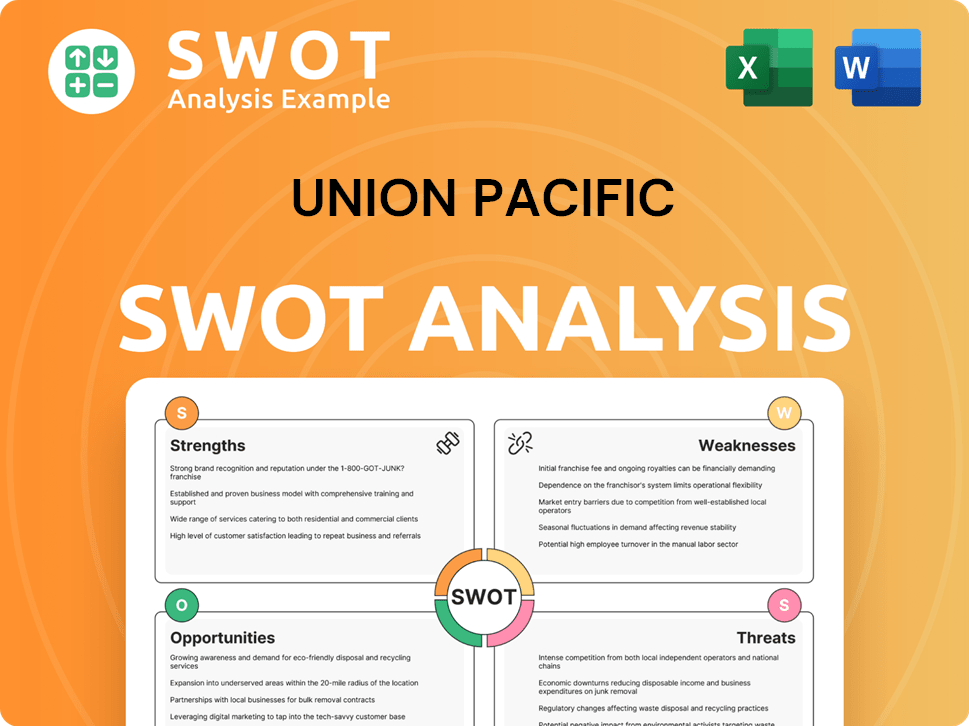
How Has Union Pacific’s Ownership Changed Over Time?
Union Pacific Corporation (UP), a major railroad company, is a publicly traded entity listed on the New York Stock Exchange (NYSE) under the symbol 'UNP'. As of June 11, 2025, the stock price was $225.72 per share. The ownership structure is primarily dominated by institutional investors, who collectively hold a significant portion of the shares. This heavy institutional presence means that the company's stock price can be sensitive to their trading activities.
As of March 31, 2025, there were 3,853 institutional owners and shareholders, holding a total of 570,885,223 shares. The largest institutional shareholders include Vanguard Group Inc., holding 9.85% (58,831,282 shares), BlackRock, Inc. with 7.57% (45,226,532 shares), and State Street Corp with 4.26% (25,461,115 shares). Other significant institutional investors include JPMorgan Chase & Co., Geode Capital Management, LLC, Bank of America Corp, Morgan Stanley, and Capital Research Global Investors. Insider ownership is relatively low, approximately 0.11% to 1.35% of the stock. Retail investors, including public companies and individual investors, hold approximately 18.62% to 36.50% of the company's stock.
| Date | Event | Impact on Ownership |
|---|---|---|
| 1901 | Acquisition of 46% interest in Southern Pacific Railroad | Increased Union Pacific's stake in the railroad industry. |
| 1913 | Forced sale of Southern Pacific Railroad stake | Due to antitrust concerns, Union Pacific had to divest its interest. |
| 1982 | Acquisition of Missouri Pacific Railroad and Western Pacific Railroad | Expanded Union Pacific's rail network. |
| June 1995 | Acquisition of Chicago and North Western Transportation Company | Further expanded Union Pacific's rail network. |
| 1996 | Acquisition of Southern Pacific Rail Corporation | Significantly increased Union Pacific's market position and system size. |
Union Pacific's history includes significant ownership shifts due to mergers and acquisitions. These strategic moves, such as the 1982 acquisitions of Missouri Pacific Railroad and Western Pacific Railroad, and the 1996 acquisition of Southern Pacific Rail Corporation, have reshaped the company's market position. To learn more about the company's financial aspects, consider reading the article: Revenue Streams & Business Model of Union Pacific.
Understanding Union Pacific ownership is crucial for investors and stakeholders.
- Institutional investors hold the majority of shares.
- Major shareholders include Vanguard, BlackRock, and State Street.
- Historical acquisitions have significantly impacted the company's structure.
- The stock symbol for Union Pacific is UNP.
Union Pacific PESTLE Analysis
- Covers All 6 PESTLE Categories
- No Research Needed – Save Hours of Work
- Built by Experts, Trusted by Consultants
- Instant Download, Ready to Use
- 100% Editable, Fully Customizable
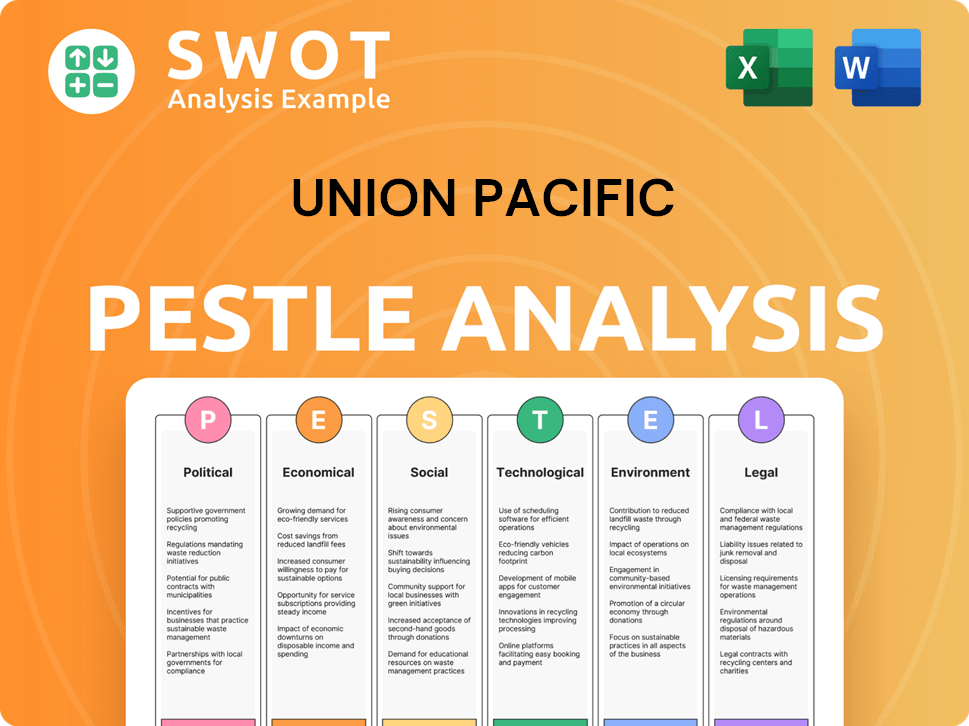
Who Sits on Union Pacific’s Board?
The Board of Directors of Union Pacific (UP), a leading railroad company, oversees crucial aspects such as strategic planning, financial and risk management, and corporate governance. The board aims to maintain a size between 10 and 14 members, with a limit of two management directors. The board structure includes an independent Chairman, separating this role from the CEO. This structure is designed to ensure effective oversight and accountability, which is vital for Union Pacific ownership.
In director elections, directors are elected by a majority vote. This means that the number of shares voted 'for' must exceed those voted 'against'. Directors who are not re-elected must cease to serve within 90 days of the vote certification. Non-management directors are not eligible for re-election after reaching 75 years of age. The board operates through several standing committees, including the Audit Committee, Finance Committee, Compensation and Benefits Committee, and the Corporate Governance, Nominating, and Sustainability Committee. These committees support the board in its oversight responsibilities and are key for investors.
| Board Member | Title | Affiliation |
|---|---|---|
| Lance Fritz | Chairman, President and CEO | Union Pacific |
| Michael McCarthy | Lead Independent Director | Former CEO, Cigna Corp. |
| Debra Reed-Klages | Director | Former Chairman and CEO, Sempra Energy |
As of May 8, 2025, Union Pacific held its Annual Meeting of Stockholders, where all nominated directors were elected for a one-year term with a significant majority of votes, which shows strong shareholder confidence. The 'Say on Pay' proposal, an advisory vote on executive compensation, was also approved by stockholders, reflecting alignment on compensation practices. Investors interested in understanding the competitive landscape can refer to Competitors Landscape of Union Pacific for additional insights.
The Board of Directors plays a vital role in Union Pacific's strategic direction and financial oversight. The board's structure, including the independent Chairman and various committees, supports effective governance. Shareholder votes and the 'Say on Pay' approval indicate strong confidence in the current governance practices, which are important for investors.
- The board consists of 10-14 members.
- Directors are elected by a majority vote.
- Non-management directors cannot be re-elected after 75 years of age.
- The Annual Meeting of Stockholders in May 2025 saw all directors elected.
Union Pacific Business Model Canvas
- Complete 9-Block Business Model Canvas
- Effortlessly Communicate Your Business Strategy
- Investor-Ready BMC Format
- 100% Editable and Customizable
- Clear and Structured Layout
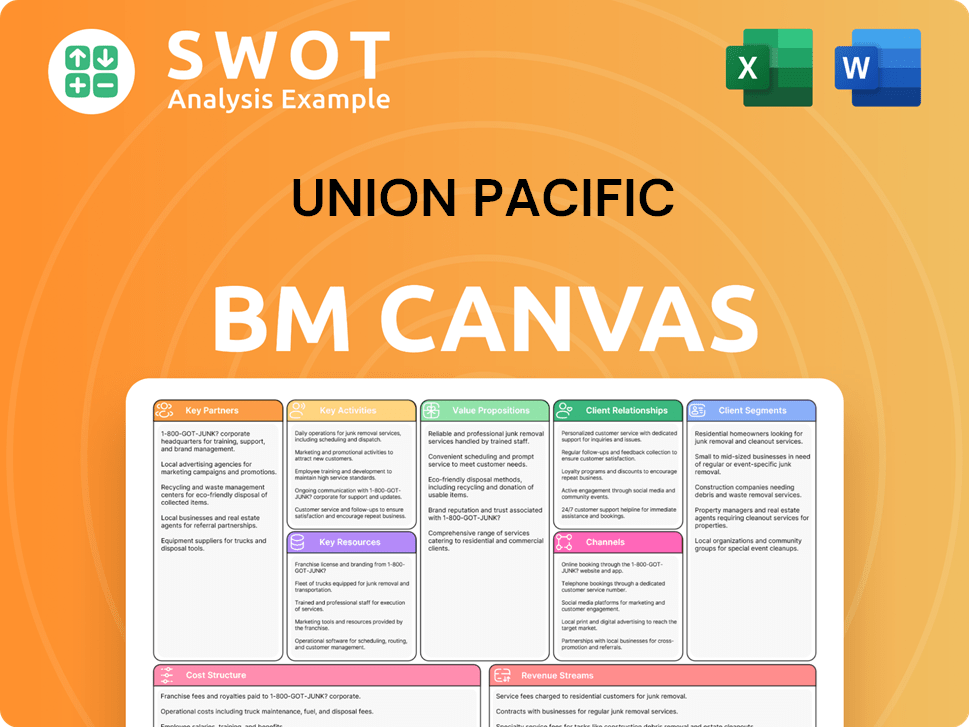
What Recent Changes Have Shaped Union Pacific’s Ownership Landscape?
In the past few years, the ownership structure of the railroad company Union Pacific (UP) has remained largely consistent, with institutional investors holding a significant majority of shares. As of January 14, 2025, institutions owned approximately 81% of the company's stock. This high level of institutional ownership is typical for large, publicly traded companies like UP. The concentration of ownership is further illustrated by the fact that the top 25 shareholders control around 47% of the company.
Examining insider trading activity provides another perspective on ownership trends. Over the last two years, insiders have sold a total of 33,271 shares, valued at over $7.9 million. During the same period, they purchased 4,500 shares for approximately $999,000. Recent insider sales in 2025 include transactions by Craig V. Richardson, Elizabeth F. Whited, Eric J. Gehringer, Jennifer L. Hamann, and Kenyatta G. Rocker. This data provides insight into the perspectives of those closest to the company's operations.
| Date | Insider | Transaction Type | Shares | Value |
|---|---|---|---|---|
| 2025 | Craig V. Richardson | Sale | Various | Various |
| 2025 | Elizabeth F. Whited | Sale | Various | Various |
| 2025 | Eric J. Gehringer | Sale | Various | Various |
| 2025 | Jennifer L. Hamann | Sale | Various | Various |
| 2025 | Kenyatta G. Rocker | Sale | Various | Various |
In December 2023, Union Pacific appointed John Tien to its board of directors. This addition brought expertise in global operations, technology, and risk management, reflecting the company's strategic focus. The appointment is particularly relevant given that 40% of UP's shipments either originate or terminate outside the U.S. This strategic move aligns the board's expertise with the company's evolving needs. At the Annual Meeting on May 8, 2025, approximately 88% of outstanding shares were represented. Key proposals, including the election of directors and the ratification of the independent accounting firm for 2025, passed with significant majorities. However, a shareholder proposal for an amended clawback policy did not pass. The stock was trading near its 52-week low, presenting an interesting situation for potential investors.
Institutional investors hold a significant majority of Union Pacific shares. As of January 2025, institutions owned approximately 81% of the company. The top 25 shareholders control around 47% of the company.
Insiders have sold a total of 33,271 shares in the last 24 months, valued over $7.9 million, while purchasing 4,500 shares for approximately $999,000. Recent sales occurred in 2025.
In December 2023, John Tien joined the board, adding global perspective. Shareholder participation at the May 8, 2025, meeting was high. Key proposals passed, while a clawback policy proposal did not.
The company's stock was trading near its 52-week low as of the meeting. This could present an interesting situation for potential investors looking at the Union Pacific ownership structure.
Union Pacific Porter's Five Forces Analysis
- Covers All 5 Competitive Forces in Detail
- Structured for Consultants, Students, and Founders
- 100% Editable in Microsoft Word & Excel
- Instant Digital Download – Use Immediately
- Compatible with Mac & PC – Fully Unlocked
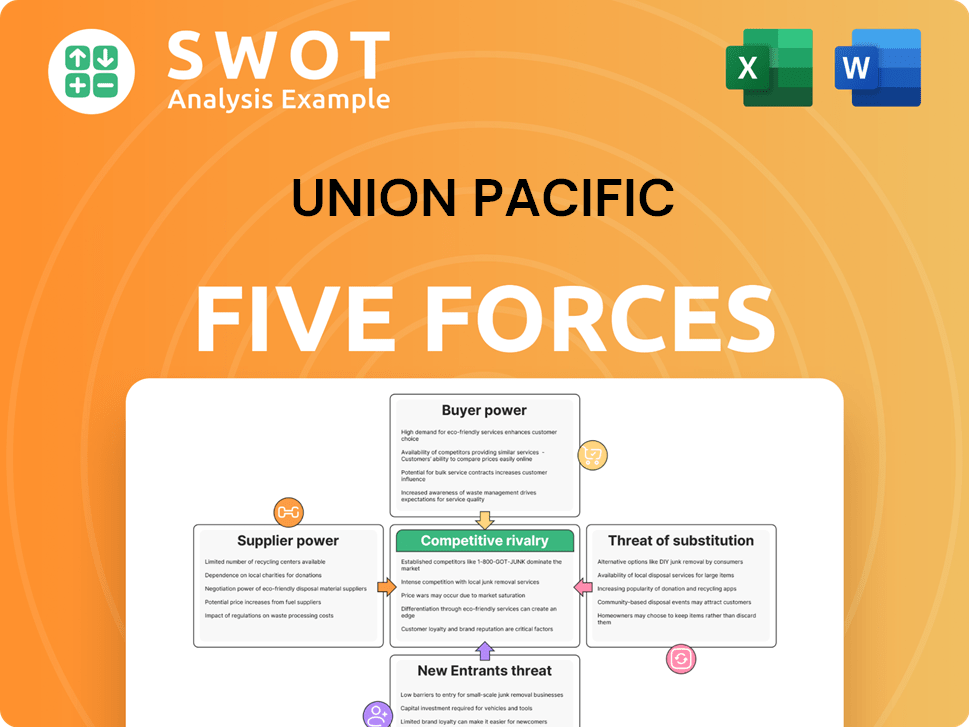
Related Blogs
- What are Mission Vision & Core Values of Union Pacific Company?
- What is Competitive Landscape of Union Pacific Company?
- What is Growth Strategy and Future Prospects of Union Pacific Company?
- How Does Union Pacific Company Work?
- What is Sales and Marketing Strategy of Union Pacific Company?
- What is Brief History of Union Pacific Company?
- What is Customer Demographics and Target Market of Union Pacific Company?
Disclaimer
All information, articles, and product details provided on this website are for general informational and educational purposes only. We do not claim any ownership over, nor do we intend to infringe upon, any trademarks, copyrights, logos, brand names, or other intellectual property mentioned or depicted on this site. Such intellectual property remains the property of its respective owners, and any references here are made solely for identification or informational purposes, without implying any affiliation, endorsement, or partnership.
We make no representations or warranties, express or implied, regarding the accuracy, completeness, or suitability of any content or products presented. Nothing on this website should be construed as legal, tax, investment, financial, medical, or other professional advice. In addition, no part of this site—including articles or product references—constitutes a solicitation, recommendation, endorsement, advertisement, or offer to buy or sell any securities, franchises, or other financial instruments, particularly in jurisdictions where such activity would be unlawful.
All content is of a general nature and may not address the specific circumstances of any individual or entity. It is not a substitute for professional advice or services. Any actions you take based on the information provided here are strictly at your own risk. You accept full responsibility for any decisions or outcomes arising from your use of this website and agree to release us from any liability in connection with your use of, or reliance upon, the content or products found herein.